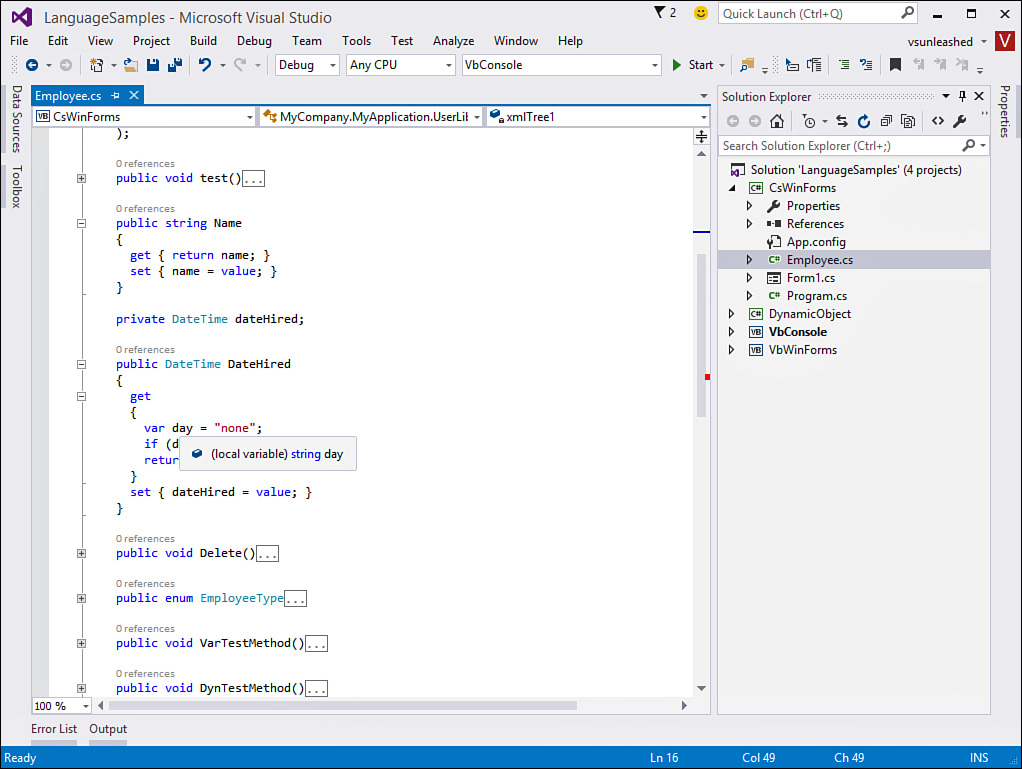Infer a Variable’s Data Type Based on Assignment
In the later versions of Visual Basic and C# (2008 and later), you can define variables without explicitly setting their data type. And, when doing so, you can still get the benefits of strongly typed variables (compiler checking, memory allocation, and more). The compilers actually infer the data type you intend to use based on your code. This process is called local type inference or implicit typing.
For example, consider the following lines of code. Here you create a variable of type String and assign a value.
C#
string companyName = "Contoso";
VB
Dim companyName As String = "Contoso"
Now, let’s look at the same line of code using type inference. You can see that you do not need the string portion of the declaration. Instead, the compiler is able to determine that you want a string and strongly types the variable for you. In C#, this is triggered by the keyword var. This should not be confused with the var statement in languages such as JavaScript. Variables defined as var are strongly typed. In Visual Basic, you still simply use the Dim statement but omit the data type.
C#
var companyName = "Contoso";
VB
Dim companyName = "Contoso"
These two lines of code are equivalent in all ways. Although in the second example no data type was declared, one is being declared by the compiler. This is not a return to a generalized data type such as Variant or Object. Nor does this represent late-binding of the variable. Rather, it is simply a smarter compiler that strongly types the variable by choosing a data type based on the code. You get all the benefits of early-bound variables while saving some keystrokes.
For example, take a look at Figure 3.3. This is the C# compiler in action. (The Visual Basic compiler does the same thing.) You can see that even at development time, the compiler has determined that this variable is of type System.String.
There are a few things for you to be aware of when using type inference. The first is that it requires your local variable to be assigned a value to do the compiler typing. This should not be a big deal because if your variable is not assigned, it is not used.
The second item you should consider is that type inference works only with local variables. It does not work with class-level variables (also called fields) or static variables. In these cases, using local type inference results in the compiler throwing an error in C#. In Visual Basic, you would get the same error provided that Option Strict is set to On. If you are not using Option Strict in your Visual Basic code, the variable is not strongly typed. Instead, the variable is assigned the generic Object data type.
Local type inference can be useful in other declaration scenarios as well. This includes defining arrays, creating variables during looping, defining a variable inside a Using statement, and defining a variable that contains the result of a function call. In each of these cases, the compiler can infer your data type based on the context of the code.
As another example, the following code creates a Using statement and infers the type of the variable cnn (as a SqlConnection object). Note that a Using block defines a block of code for which a given resource is being used. The use of a Using block guarantees that the runtime disposes of the used object (in this case, the database connection) when done.
C#
using (var cnn = new System.Data.SqlClient.SqlConnection()) {
//code to work with the connection
}
VB
Using cnn = New System.Data.SqlClient.SqlConnection
'code to work with the connection
End Using
In Visual Basic, you can turn local type inference off and on for a given file. By default, a new Visual Basic code file is set to allow type inference. However, if you want to turn it off at the file level, you can do so by setting Option Infer Off at the top of the code file.

